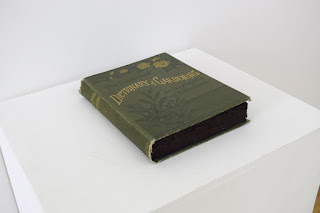The state of being of the animals was important as they revealed the passing of time physically but also of our ideas about "nature". And there were interventions that aimed at dislocating our perception to create a sense of mistrust or fiction.
So the works/experiments consisted in: real leaves (in order) and paper leaves (in apparent disorder); real bones and bones made out of paper pulp from books on Zoology; real branches and intervened ones; a wheelbarrow carrying a diorama of a dead tree; books about gardening which are made out of soil into a perfect angled shape almost like hedge trimming; a dead fly placed over (outside) a discarded entomology case; Paper insects that depict camouflaging species, I always loved the fact that the Phasmatoidea looked like leaves. And in their first observations they were thought as leaves. But the camouflage does not only consist in the image but also in the movement, to imitate the movement of the leaf being moved slightly by the wind. There was some real insects walking around the sculpture, it was a moment of surprise; leaves on the floor which have been violently cut to form a perfect square; a pile of rocks, both found and manmade in a corner; empty pages with the perfect void of leaves in them, which depicts the space from leaves but which are on the floor; paper insects placed in a spiderweb and the interaction of the spider with them being caught on film; real grass and fake grass, being unrolled; a buddleia that has sprouted from a pillar, that in a way resembles a tree, it has been painted white just as the pillar. The art space and botany. A place of tension, the conservationists nightmare of nature. Of trying to stop decay and the natural cycle. To welcome it in; the stuffed birds placed on tree branches being filmed, the unbearable stillness of death but the soothing movement of the wind. To mortalize rather than immortalize; the sound of the outside inside the space, the glass keeping us separated; a book that is turned into bone, the fossilization of knowledge, working as an agent. Language and words into the remains of life. For that bone to exist the zoology book has been compromised. It´s a parasitical relationship. Having an impact in culture the same way we create an impact in the natural world, through understanding and knowing; stuffed birds and mice placed over the light panels; a paper mosquito placed in the pillar.
I tried to embrace some of the complexities and contradictions in our relationship with the natural world. So the tradition of the diorama is a place of contingency. Maybe it is the base of some of our misconceptions in regard to other species.
So there was a strong sense of
not knowing if everything is real or not. It was in itself a hybrid between nature and culture, a state
of confusion which I think is what is actually happening.
If the apparent "liveness" or accuracy of the taxidermied animals is what holds a great part of their scientific intention then what happens when they are placed in a context that aims at expanding and questioning these notions? Hopefully they become part of the simulation to reflect themselves.
I would like to thank Glen Stoker, Anna Francis, Glenn Roadley, Rebecca Davies, Alice Thatch, the volunteers at the Natural History Collection, AirSpace Gallery and the Potteries Museum & Art Gallery.
Below is a selection of images from the Residency.





















































No comments:
Post a Comment